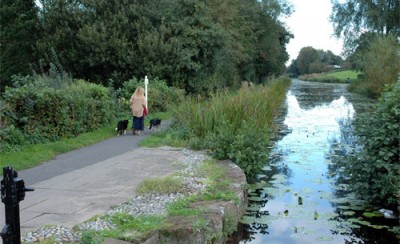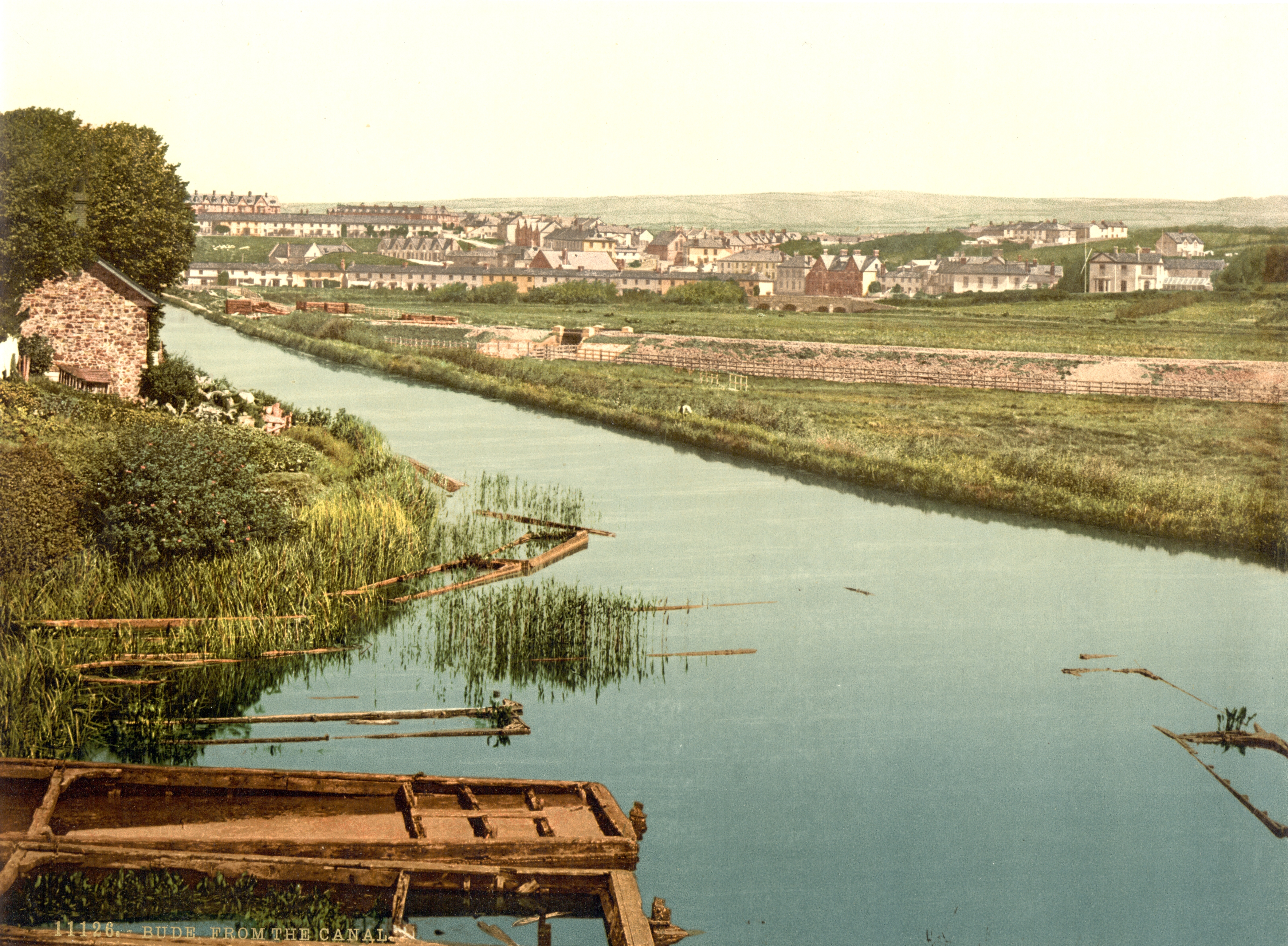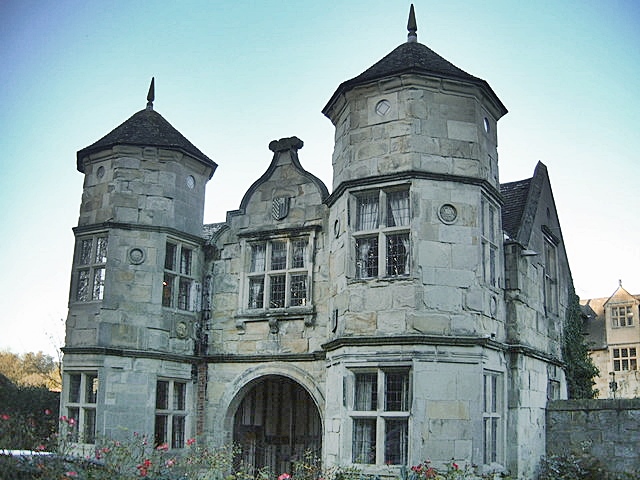|
Wombridge Canal
The Wombridge Canal was a tub-boat canal in Shropshire, England, built to carry coal and iron ore from mines in the area to the furnaces where the iron was extracted. It opened in 1788, and parts of it were taken over by the Shrewsbury Canal Company in 1792, who built an inclined plane at Trench. It lowered tub boats , and remained in operation until 1921, becoming the last operational canal inclined plane in the country. The canal had been little used since 1919, and closed with the closure of the plane. History Iron ore and coal were mined at Wombridge, near to the church. In order to transport it to the furnaces at Donnington Wood, William Reynolds started to build a tub-boat canal in 1787. It was completed in 1788, at a cost of £1,640 and was long, connecting with both the furnaces and the Donnington Wood Canal. A curious feature of the canal was the tunnel which was constructed near to the church. There is no obvious reason for it, and it has been suggested that it ... [...More Info...] [...Related Items...] OR: [Wikipedia] [Google] [Baidu] |
Shrewsbury Canal
The Shrewsbury Canal (or Shrewsbury and Newport Canal) was a canal in Shropshire, England. Authorised in 1793, the main line from Trench to Shrewsbury was fully open by 1797, but it remained isolated from the rest of the canal network until 1835, when the Birmingham and Liverpool Junction Canal built the Newport Branch from Norbury Junction to a new junction with the Shrewsbury Canal at Wappenshall. After ownership passed to a series of railway companies, the canal was officially abandoned in 1944; many sections have disappeared, though some bridges and other structures can still be found. There is an active campaign to preserve the remnants of the canal and to restore the Norbury to Shrewsbury line to navigation. History From 1768 several small canals were built in the area of what is now Telford. These canals carried tub boats. The first of these was the Donnington Wood Canal which opened in 1768, to be followed by the Wombridge Canal and the Ketley Canal, both opened in 1 ... [...More Info...] [...Related Items...] OR: [Wikipedia] [Google] [Baidu] |
Donnington Wood Canal
The Donnington Wood Canal was a private canal in East Shropshire, England, which ran from coal pits owned by Earl Gower at Donnington Wood to Pave Lane on the Wolverhampton to Newport Turnpike Road. It was completed in about 1767 and abandoned in 1904. The canal was part of a larger network of tub-boat canals, which were used for the transport of raw materials, particularly coal, limestone and ironstone, from the locations where they were mined to furnaces where the iron ore was processed. The canal was connected to the Wombridge Canal and the Shropshire Canal. History Lord Gower, the brother-in-law of the Duke of Bridgewater, who had pioneered the canal age with his Bridgewater Canal, was the owner of limestone quarries and coal mines in Shropshire. Recognising the potential of canals for the carriage of heavy goods, he formed the Earl Gower & Company in 1764, joining forces with two land agents, John and Thomas Gilbert. Together, they planned a private canal from Lord ... [...More Info...] [...Related Items...] OR: [Wikipedia] [Google] [Baidu] |
Shropshire
Shropshire (; alternatively Salop; abbreviated in print only as Shrops; demonym Salopian ) is a landlocked historic county in the West Midlands region of England. It is bordered by Wales to the west and the English counties of Cheshire to the north, Staffordshire to the east, Worcestershire to the southeast, and Herefordshire to the south. A unitary authority of the same name was created in 2009, taking over from the previous county council and five district councils, now governed by Shropshire Council. The borough of Telford and Wrekin has been a separate unitary authority since 1998, but remains part of the ceremonial county. The county's population and economy is centred on five towns: the county town of Shrewsbury, which is culturally and historically important and close to the centre of the county; Telford, which was founded as a new town in the east which was constructed around a number of older towns, most notably Wellington, Dawley and Madeley, which is tod ... [...More Info...] [...Related Items...] OR: [Wikipedia] [Google] [Baidu] |
Canal Inclined Plane
An inclined plane is a type of cable railway used on some canals for raising boats between different water levels. Boats may be conveyed afloat, in caissons, or may be carried in cradles or slings. History Inclined planes have evolved over the centuries. Some of the first were used by the Egyptians to bypass waterfalls on the Nile. These consisted of wooden slides covered with silt which reduced friction. Timeline *600BC – The Diolkos, an early Greek inclined plane, was in use. *385AD – Inclined planes were in use on the Grand Canal in China. *1167 – Nieuwedamme ''overtoom'' (a simple type of incline) was built at Ypres. *1568 – Wagon of Zafosina in use near Venice. *1777 – 3 inclined planes or 'dry wherries' began operation on Dukart's Canal, near Coalisland, in the south-east of County Tyrone in Ulster.''Hadfield's British Canals'' eighth edition Joseph Boughey Page 49 *1788 – An inclined plane was built by William Reynolds and used, for the first time in ... [...More Info...] [...Related Items...] OR: [Wikipedia] [Google] [Baidu] |
William Reynolds (industrialist)
William Reynolds (14 April 1758 – 3 June 1803) was an ironmaster and a partner in the ironworks in Coalbrookdale in Shropshire, England. He was interested in advances in science and industry, and invented the inclined plane for canals. Early life He was born at Bank House in Ketley near Coalbrookdale, son of Richard Reynolds who was in charge of Abraham Darby II's ironworks at Ketley. Around 1777 he took over the management of the works there.''The Coalbrookdale Ironworks: a short history''. Ironbridge Gorge Museum Trust, 1975. William Reynolds's education included some time studying with the physician and chemist Joseph Black. Reynolds during his life maintained his interest in many branches of science, including chemistry, geology and mineralogy, and he had a laboratory at his home Bank House, at Ketley Bank. He was interested in the application of science in industry. With Abraham Darby he built under licence several Boulton and Watt steam engines, an early type of steam ... [...More Info...] [...Related Items...] OR: [Wikipedia] [Google] [Baidu] |
Tub Boat
A tub boat was a type of unpowered cargo boat used on a number of the early English and German canals. The English boats were typically long and wide and generally carried to of cargo, though some extra deep ones could carry up to . They are also called compartment boats or container boats. The main virtue of tub boats was their flexibility. They could be drawn in trains of 3-10 or more boats using horse power, or later steam tugs, where the number of boats was varied according to the type of cargo. Tubs could be lifted more easily than larger boats and tub boat lifts and inclined planes were developed as an alternative to canal locks, particularly in or near a colliery or similar industrial works. At a lift the train could easily be divided, the boats lifted individually, and the train reassembled afterwards. Sometimes the boats used snug-fitting non-waterproof inner containers which could be more easily lifted out. Because of their small size, the canals that were built ... [...More Info...] [...Related Items...] OR: [Wikipedia] [Google] [Baidu] |
Old Mill, Wrockwardine Wood - Geograph
Old or OLD may refer to: Places *Old, Baranya, Hungary *Old, Northamptonshire, England *Old Street station, a railway and tube station in London (station code OLD) *OLD, IATA code for Old Town Municipal Airport and Seaplane Base, Old Town, Maine, United States People *Old (surname) Music *OLD (band), a grindcore/industrial metal group * ''Old'' (Danny Brown album), a 2013 album by Danny Brown * ''Old'' (Starflyer 59 album), a 2003 album by Starflyer 59 * "Old" (song), a 1995 song by Machine Head *''Old LP'', a 2019 album by That Dog Other uses * ''Old'' (film), a 2021 American thriller film *''Oxford Latin Dictionary'' *Online dating *Over-Locknut Distance (or Dimension), a measurement of a bicycle wheel and frame *Old age See also *List of people known as the Old * * *Olde, a list of people with the surname *Olds (other) Olds may refer to: People * The olds, a jocular and irreverent online nickname for older adults * Bert Olds (1891–1953), Australian rules ... [...More Info...] [...Related Items...] OR: [Wikipedia] [Google] [Baidu] |
Madeley, Shropshire
Madeley is a constituent town and civil parish in Telford and Wrekin in Shropshire, England. The parish had a population of 17,935 at the 2001 census. Madeley is recorded in the Domesday Book, having been founded before the 8th century. Historically, Madeley's industrial activity has largely been in mining, and later, manufacturing, which is still a large employer in the town, along with service industries. Parts of the parish fall within the UNESCO World Heritage Site of Ironbridge Gorge, the site of The Iron Bridge, and a key area in the development of Industry. History The settlement of Madeley is recorded as far back as the Domesday Book. The town was founded prior to the 8th century, and subsequently became a market town in the 13th century. Sigward, a local ruler in the time of King Æthelbald of Mercia, is said to have held 3 hides of land at Madeley. Between 727 and 736 he sold his holdings to Mildburh, daughter of Merewalh, sub-king of the Magonsæte. She was ... [...More Info...] [...Related Items...] OR: [Wikipedia] [Google] [Baidu] |
Gelignite
Gelignite (), also known as blasting gelatin or simply "jelly", is an explosive material consisting of collodion-cotton (a type of nitrocellulose or guncotton) dissolved in either nitroglycerine or nitroglycol and mixed with wood pulp and saltpetre (sodium nitrate or potassium nitrate). It was invented in 1875, by Swedish chemist Alfred Nobel, who also invented dynamite. It is more stable than dynamite, but can still suffer from "sweating" or leaching out nitroglycerine. Its composition makes it easily moldable and safe to handle without protection, as long as it is not near anything capable of detonating it. One of the cheapest explosives, it burns slowly and cannot explode without a detonator, so it can be stored safely. In the United Kingdom, an explosives certificate, issued by the local Chief Officer of Police, is required for possession of gelignite. Due to its widespread civilian use in quarries and mining, it has historically been used by terrorist groups such as th ... [...More Info...] [...Related Items...] OR: [Wikipedia] [Google] [Baidu] |
Canals In Shropshire
Canals or artificial waterways are waterways or engineered channels built for drainage management (e.g. flood control and irrigation) or for conveyancing water transport vehicles (e.g. water taxi). They carry free, calm surface flow under atmospheric pressure, and can be thought of as artificial rivers. In most cases, a canal has a series of dams and locks that create reservoirs of low speed current flow. These reservoirs are referred to as ''slack water levels'', often just called ''levels''. A canal can be called a ''navigation canal'' when it parallels a natural river and shares part of the latter's discharges and drainage basin, and leverages its resources by building dams and locks to increase and lengthen its stretches of slack water levels while staying in its valley. A canal can cut across a drainage divide atop a ridge, generally requiring an external water source above the highest elevation. The best-known example of such a canal is the Panama Canal. Many ca ... [...More Info...] [...Related Items...] OR: [Wikipedia] [Google] [Baidu] |
Canals Opened In 1788
Canals or artificial waterways are waterways or engineered channels built for drainage management (e.g. flood control and irrigation) or for conveyancing water transport vehicles (e.g. water taxi). They carry free, calm surface flow under atmospheric pressure, and can be thought of as artificial rivers. In most cases, a canal has a series of dams and locks that create reservoirs of low speed current flow. These reservoirs are referred to as ''slack water levels'', often just called ''levels''. A canal can be called a ''navigation canal'' when it parallels a natural river and shares part of the latter's discharges and drainage basin, and leverages its resources by building dams and locks to increase and lengthen its stretches of slack water levels while staying in its valley. A canal can cut across a drainage divide atop a ridge, generally requiring an external water source above the highest elevation. The best-known example of such a canal is the Panama Canal. Many ... [...More Info...] [...Related Items...] OR: [Wikipedia] [Google] [Baidu] |







